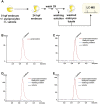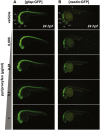The larvicide pyriproxyfen blamed during the Zika virus outbreak does not cause microcephaly in zebrafish embryos
- PMID: 28051181
- PMCID: PMC5209666
- DOI: 10.1038/srep40067
The larvicide pyriproxyfen blamed during the Zika virus outbreak does not cause microcephaly in zebrafish embryos
Abstract
Although the zika virus (ZIKV) has now been strongly correlated with emerging cases of microcephaly in the Americas, suspicions have been raised regarding the use of pyriproxyfen, a larvicide that prevents mosquito development, in drinking water. The effects of this compound on neurodevelopment have not yet been addressed specifically in vertebrates. As a result, we aimed at addressing the effects, if any, of pyriproxyfen on neurodevelopment in the zebrafish embryo as a vertebrate model. Using zebrafish transgenic lines expressing GFP in different cell populations (elavl3 in newborn neurons, gfap and nestin in neural stem cells), we focused on the analysis of whole embryonic brain volume after confocal 3D-reconstruction and the quantification of purified neural stem cells during early neurodevelopment by FACS-cell sorting from whole in vivo embryos. Interestingly, though lethal at very high doses, pyriproxyfen did not cause brain malformation nor any significant changes in the number of observed stem cells in the developing central nervous system. Our data indicate that pyriproxyfen does not affect central nervous system development in zebrafish, suggesting that this larvicide on its own, may not be correlated with the increase in microcephaly cases reported recently.
Figures





Similar articles
-
A systems biology approach to predictive developmental neurotoxicity of a larvicide used in the prevention of Zika virus transmission.Toxicol Appl Pharmacol. 2018 Sep 1;354:56-63. doi: 10.1016/j.taap.2018.02.014. Epub 2018 Feb 21. Toxicol Appl Pharmacol. 2018. PMID: 29476864 Free PMC article.
-
Assessment of the developmental and neurotoxicity of the mosquito control larvicide, pyriproxyfen, using embryonic zebrafish.Environ Pollut. 2016 Nov;218:1089-1093. doi: 10.1016/j.envpol.2016.08.061. Epub 2016 Sep 1. Environ Pollut. 2016. PMID: 27593350 Free PMC article.
-
Pyriproxyfen and the microcephaly epidemic in Brazil - an ecological approach to explore the hypothesis of their association.Mem Inst Oswaldo Cruz. 2016 Dec;111(12):774-776. doi: 10.1590/0074-02760160291. Epub 2016 Oct 31. Mem Inst Oswaldo Cruz. 2016. PMID: 27812601 Free PMC article.
-
Zika infection and the development of neurological defects.Cell Microbiol. 2017 Jun;19(6). doi: 10.1111/cmi.12744. Epub 2017 May 3. Cell Microbiol. 2017. PMID: 28370966 Review.
-
How does Zika virus cause microcephaly?Genes Dev. 2017 May 1;31(9):849-861. doi: 10.1101/gad.298216.117. Genes Dev. 2017. PMID: 28566536 Free PMC article. Review.
Cited by
-
A zebrafish-based in vivo model of Zika virus infection unveils alterations of the glutamatergic neuronal development and NS4A as a key viral determinant of neuropathogenesis.PLoS Pathog. 2024 Dec 2;20(12):e1012756. doi: 10.1371/journal.ppat.1012756. eCollection 2024 Dec. PLoS Pathog. 2024. PMID: 39621753 Free PMC article.
-
Impact of Zika virus for infertility specialists: current literature, guidelines, and resources.J Assist Reprod Genet. 2017 Oct;34(10):1237-1250. doi: 10.1007/s10815-017-0988-1. Epub 2017 Jul 7. J Assist Reprod Genet. 2017. PMID: 28687969 Free PMC article. Review.
-
Big Data to Knowledge Analytics Reveals the Zika Virus Epidemic as Only One of Multiple Factors Contributing to a Year-Over-Year 28-Fold Increase in Microcephaly Incidence.Int J Environ Res Public Health. 2022 Jul 25;19(15):9051. doi: 10.3390/ijerph19159051. Int J Environ Res Public Health. 2022. PMID: 35897436 Free PMC article.
-
Are internet videos useful sources of information during global public health emergencies? A case study of YouTube videos during the 2015-16 Zika virus pandemic.Pathog Glob Health. 2018 Sep;112(6):320-328. doi: 10.1080/20477724.2018.1507784. Epub 2018 Aug 29. Pathog Glob Health. 2018. PMID: 30156974 Free PMC article.
-
A systems biology approach to predictive developmental neurotoxicity of a larvicide used in the prevention of Zika virus transmission.Toxicol Appl Pharmacol. 2018 Sep 1;354:56-63. doi: 10.1016/j.taap.2018.02.014. Epub 2018 Feb 21. Toxicol Appl Pharmacol. 2018. PMID: 29476864 Free PMC article.
References
-
- Corona-Rivera J. R. et al.. Report and review of the fetal brain disruption sequence. Eur J Pediatr 160, 664–667 (2001). - PubMed
Publication types
MeSH terms
Substances
Grants and funding
LinkOut - more resources
Full Text Sources
Other Literature Sources
Molecular Biology Databases
Research Materials
Miscellaneous

